Manuscript E.R.
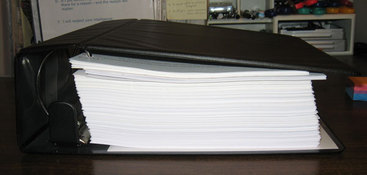 Been working hard on revisions to
Sarya's Song
and Daughter of the Wildings, and thought I'd come up for air and show my readers a little of the process I use to take a manuscript from not so great to, well, maybe not great but a lot better than it was!
Been working hard on revisions to
Sarya's Song
and Daughter of the Wildings, and thought I'd come up for air and show my readers a little of the process I use to take a manuscript from not so great to, well, maybe not great but a lot better than it was!I've learned revision through many years of revising novels, but the best method I've learned has been Holly Lisle's How To Revise Your Novel course. Ms. Lisle worked as an emergency room nurse for many years, and this general approach to revision can be likened to taking care of a patient in the E.R. When the patient first arrives, you don't start just randomly doing surgery on him. First you have to figure out what's wrong (and also what isn't wrong, so you don't end up removing a perfectly good spleen or something), then you make a plan for fixing it, then you take him into surgery and start cutting. Likewise, in this approach, you don't just start crossing stuff out in your manuscript right away; first you figure out what's wrong with it (and what's right), then you make your revision plan, THEN you get out the red pen and start making your corrections.
So, here's an overview of what goes into bringing you another fine Kyra Halland fantasy novel :D
1. I write a novel. This is a whole different process, and one I'll talk about more another time.
2. When the first draft of the novel is finished, I print it out on three-hole-punched paper and put it in a binder. This revision method will not work if you're working from a computer screen. Here's the printout of all six books of Daughter of the Wildings. My husband saw this and said, "That's a big binder." Of course, what he meant was, "Wow, I'm really impressed that you wrote something that long!" (This picture was taken right after I started the analysis or triage stage of the revision; I'm now about 2/3 through that stage.)
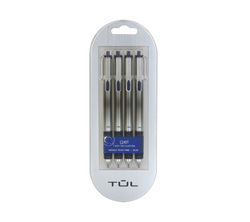 3. I make sure I have plenty of my trusty Tul Needle Point Fine Black Gel pens on hand. Then I start reading through the novel, making notes of problems I find with various aspects of the novel, such as characterization, plot, worldbuilding, patches of really bad writing, and so on. I also analyze each scene in the novel for structure and to make sure it really serves a purpose in moving the story forward. This analysis (or triage) step condenses approximately the first nine weeks of the HTRYN course into one step.
3. I make sure I have plenty of my trusty Tul Needle Point Fine Black Gel pens on hand. Then I start reading through the novel, making notes of problems I find with various aspects of the novel, such as characterization, plot, worldbuilding, patches of really bad writing, and so on. I also analyze each scene in the novel for structure and to make sure it really serves a purpose in moving the story forward. This analysis (or triage) step condenses approximately the first nine weeks of the HTRYN course into one step.4. Once I've gone all the way through the manuscript and made my notes, I get out a bunch of index cards (index cards are key to this method, and I've developed something of a fetish for them :D). I make an index card for each scene as I want that scene to be (not as it is now), giving a one-sentence summary of the scene and what the scene is supposed to accomplish, story-wise. Then, referring to my sheaves of notes, I write a summary on the back of each card of the changes I want to make in each scene. Finally, I color-code each card with a post-it, showing approximately how much work each scene is going to need. Neon green means I'll be changing up to about 25% of the scene, bright yellow means 25-50%, neon orange is 50-75%, hot pink is 75-100% or a completely new scene. (I love post-its. Along with 3-hole-punched printer paper, Tul pens, and index cards, they're one of my essential non-computer writing tools.)
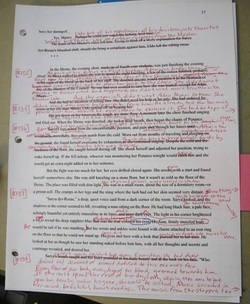 5. Once I've got my plan in place, I start marking up the manuscript. This can get pretty messy (like a good bout of surgery). I use red pen for corrections, and I've also learned to keep a blue pen handy to un-correct, that is, to mark where I've made changes in red and then changed my mind and decided to keep the original. Where it gets really interesting is where I've marked out a correction in red, and then decided to keep it, so I've got my changes circled in blue to not change them... Or something. It all makes sense when I'm doing it. To illustrate, I took some photos of pages from the current revision of Sarya's Song. (Warning: not for the squeamish.)
5. Once I've got my plan in place, I start marking up the manuscript. This can get pretty messy (like a good bout of surgery). I use red pen for corrections, and I've also learned to keep a blue pen handy to un-correct, that is, to mark where I've made changes in red and then changed my mind and decided to keep the original. Where it gets really interesting is where I've marked out a correction in red, and then decided to keep it, so I've got my changes circled in blue to not change them... Or something. It all makes sense when I'm doing it. To illustrate, I took some photos of pages from the current revision of Sarya's Song. (Warning: not for the squeamish.)Here's a marked-up page; if you look closely, you can see where I circled something in blue that I had crossed out and then decided to keep. I make use of top, bottom, and side margins, and the arrows pointing off the side show where the new writing spills over onto the back.
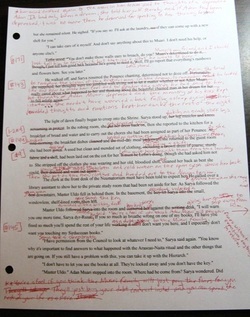 And here's another one. You can see I've got stuff going all over the place. It looks like the poor page has been savaged by rabid weasels.
And here's another one. You can see I've got stuff going all over the place. It looks like the poor page has been savaged by rabid weasels.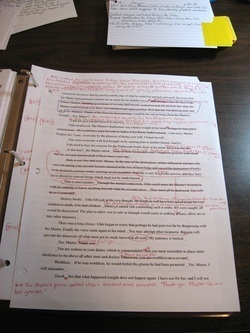 This picture shows some of my notecards. This page isn't as marked up, but you can see where I've circled chunks of text and drawn arrows showing where they should be moved to.
This picture shows some of my notecards. This page isn't as marked up, but you can see where I've circled chunks of text and drawn arrows showing where they should be moved to.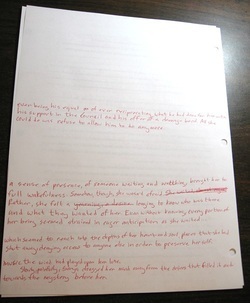 And, finally, here's the back of a page with new stuff written in. I'm about halfway through this revision of Sarya's Song, and so far I've added about 3000 words to the story.
And, finally, here's the back of a page with new stuff written in. I'm about halfway through this revision of Sarya's Song, and so far I've added about 3000 words to the story.6. Strictly speaking, you're supposed to wait until you've marked up the whole manuscript before you start typing in the corrections, but I'm afraid I'll forget what half of my arrows and cryptic scribbles mean, so I type up each day's revision when I'm finished.
I do this process twice, once on the first draft and once on the second draft after I get the feedback from the test readers. After that comes a revision to fix up any leftover bits of bad writing and continuity mistakes, then a line edit/copyedit, and then some rounds of proofreading. And, voila, a finished novel!
Update: while we're on the medical theme, I'm happy to report that after a lot of tests (including a stress test which I rocked, working out hard with absolutely no symptoms), I had an appointment with a cardiologist today and got good news (or, at least, better news than I was afraid it would be). I have a small to moderate amount of fluid around my heart (pericardial effusion), which apparently has been there for a while. It isn't causing any serious problems, except for some occasional discomfort. We're going to keep an eye on it to see what it does, if it gets worse or stays the same or goes away. In the meantime, the doctor suspects that it was caused by inflammation/autoimmune activity (which would also be consistent with my chronic fatigue syndrome) and so the next step is to see a rheumatologist. Hopefully we can pin down the underlying cause and treat it, which will control or eliminate the pericardial effusion.
***If you're a writer, I highly recommend the How To Revise Your Novel course. It's a brain-wrenching, gut-wrenching five months and costs about $250, but if you want to publish your writing, it's the best 5 months and $250 you can spend. The link is my affiliate link; I get a commission when someone buys the course through that link. But I don't promote the course because I'm an affiliate; I promote it because taking it has been the best thing I've ever done for my writing.
Published on January 24, 2014 22:04
No comments have been added yet.



